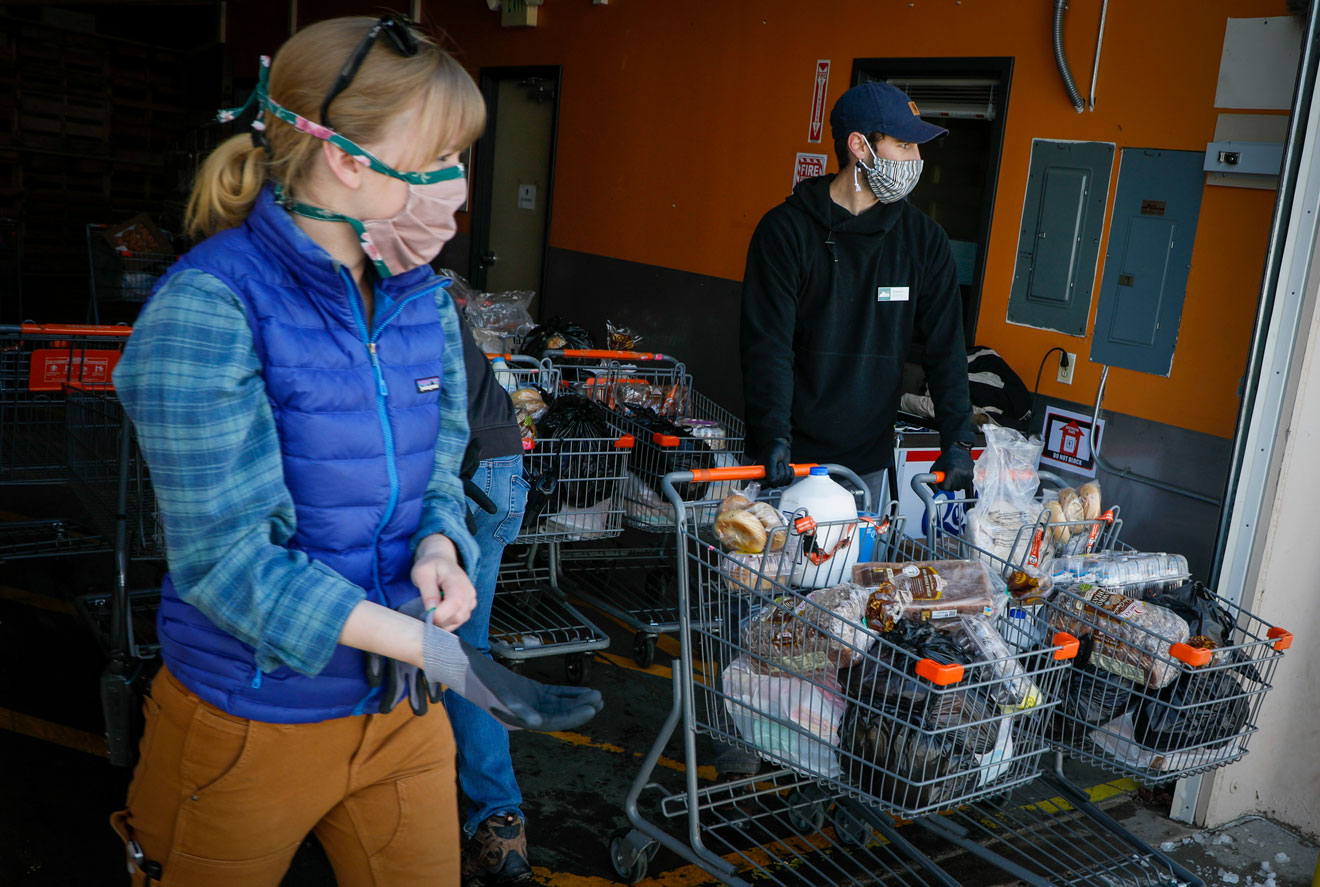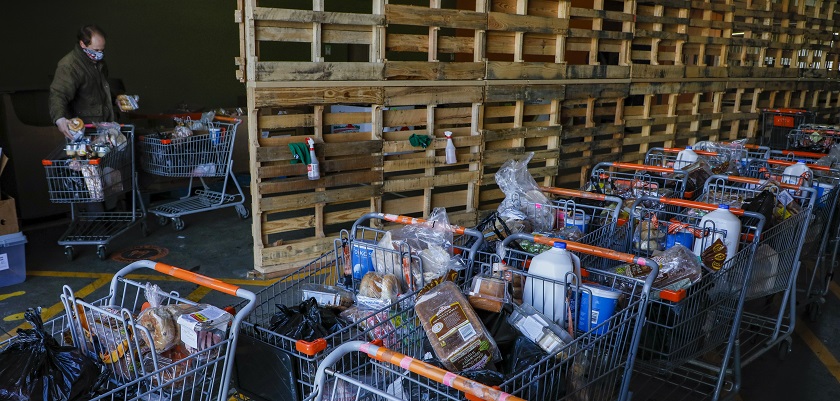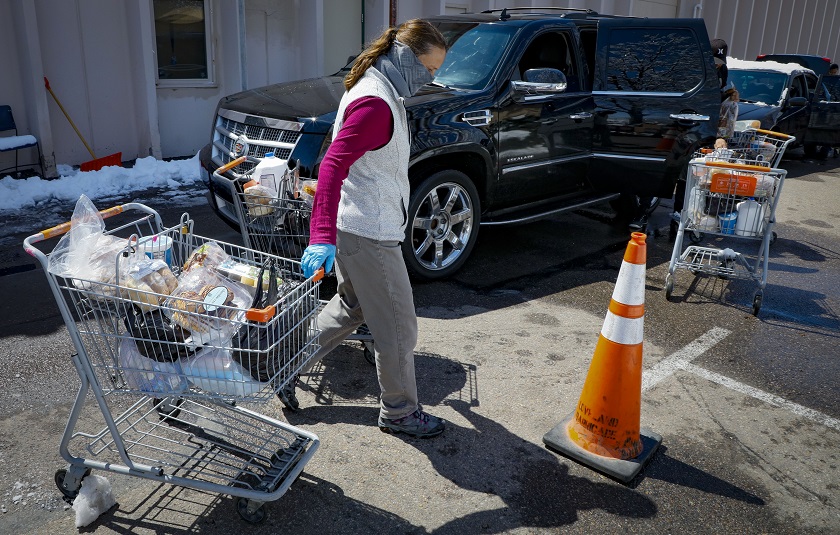
Kai Calder (l.) and Quentin Pearson watch as cars line up with people seeking grocery items at the Food Bank for Larimer County on April 17, 2020 in Fort Collins, Colo. Photos by Joe Mahoney / Special to The Colorado Trust
Kai Calder (l.) and Quentin Pearson watch as cars line up with people seeking grocery items at the Food Bank for Larimer County on April 17, 2020 in Fort Collins, Colo. Photos by Joe Mahoney / Special to The Colorado Trust
Mothers in Parachute cannot find formula to feed their babies. Isolated residents near Fairplay lack access to food. Unhoused people quarantined in a Denver motel need all meals brought to them. Migrant workers in Pueblo are without rice and beans.
With unemployment about 30 times higher than the Great Recession’s peak—231,610 initial claims were filed with the state between March 16 and April 11—the economic fallout of the weeks-old COVID-19 pandemic is emptying kitchens across Colorado. An unparalleled demand for food assistance is exacerbating inequities in place long before the virus arrived, and exposing gaps in government nutrition programs.
“Everyone needs food right now,” said Dana Wood, a project manager at the Safe and Abundant Nutrition Alliance (SANA), which serves hard-hit mountain counties on the Western Slope. “Everybody has a different heartbreaking story that goes so much beyond food.”
SANA is among 385 nonprofits that sought emergency aid after a record number of Coloradans were laid off following stay-at-home orders designed to slow the spread of the coronavirus. The Colorado Blueprint to End Hunger issued $785,000 to SANA and 69 other grantees—a fraction of the $6.8 million requested—on April 8, and plans several more rounds.
Food insecurity is sweeping the nation. As job losses and poverty escalate, an additional 17.1 million people may be unable to feed themselves in the coming months, projected Feeding America, the nation’s largest hunger-relief nonprofit. They would join 14.3 million households who couldn’t afford enough nutritious food prior to the pandemic. With demand for food aid doubling and even tripling in places, federal and state-administered programs are overwhelmed with applications.
Food banks are working overtime and hundreds of pantries nationwide closed after older volunteers decided to stay at home and staff called out sick. Reaching high-risk populations is an increasing challenge. Even nonprofits that feed pets are struggling to keep up with the need.
In Ohio and Louisiana, the National Guard is distributing groceries. Drone footage of a miles-long line of cars waiting to receive goods from a Pittsburgh food bank went viral. A community food bank in Atlanta spent about $500,000 to purchase food for seven days, 10 times more than its regular bill.
A nationwide network of 200 food banks, including five in Colorado, that receive goods from Feeding America is “facing unprecedented food shortages,” said Zuani Villarreal, director of communication, in an email. The organization has seen donations from retail and manufacturing partners, which comprise half the groceries it sends to members, plunge by 70%.
The nonprofit estimates $1.4 billion in additional resources will be needed over the next six months to provide enough food for people facing hunger. The fallout from the pandemic has already unraveled hard-fought gains to reduce food insecurity among the 50 million who experienced it at the height of the Great Recession in 2009. Only last year did these figures return to pre-recession levels.

COVID-19 is also threatening to undo progress hunger-relief organizations in Colorado had made to reach one in 10 people that experiences food insecurity, and one in six children.
The state is ranked among the lowest nationwide for participation in the federal Supplemental Nutrition Assistance Program (SNAP, formerly known as food stamps), and the Women, Infants and Children program (WIC), clocking in at 44th and 48th, respectively. Enrollment lags due to barriers such as lack of transportation, cumbersome program requirements and minimal access to community-based application assistance, a study by the Colorado Blueprint to End Hunger found.
This rate could change, as federal officials granted waiver requests from Colorado agencies to increase monthly benefit amounts, eliminate requirements for in-person interviews and revise documentation needed to qualify. The changes come as aid requests spike.
“Our counties are overwhelmed processing SNAP benefits,” said Jason Harrison, food pantry network manager for Hunger Free Colorado, which operates a hotline of navigators that assist callers in filling out such applications.
“One day recently, we helped with over 100 SNAP applications, something we typically would do in a month,” he said.
In Pitkin County, where chairlift operators, hotel cleaners and restaurant workers were among many tourism industry employees who found themselves out of work after Gov. Jared Polis ordered ski areas to close in March, almost 1,000 people filed for SNAP in a matter of weeks—a volume typically seen over six months.
Statewide, the Colorado PEAK system, where residents fill out such forms online, saw a 37% jump the week of March 22, said Karla Maraccini, director of the food and energy assistance division at the Colorado Department of Human Services.
The agency received $5.2 million in emergency food assistance as part of a congressional coronavirus relief program, but does not yet have the money in hand. About $4 million is allocated toward United States Department of Agriculture commodities for lower-income residents awaiting approval of SNAP benefits.
“If we have community areas that know they won’t get SNAP immediately, but have dire need right away, we can get them through until they get SNAP benefits,” Maraccini said. “We do get reports weekly from smaller pantries saying, ‘our shelves are bare.’ We are trying to keep everyone as stocked as possible.”

Food Bank for Larimer County staffer Deb Lippert pulls a pair of carts with grocery items to people seeking assistance.
Panic-buying that resulted from swift and ever-changing COVID-19 lockdown orders disrupted the supply chain and depleted grocery store donations that food banks and pantries in Colorado rely upon.
Trucks that typically carry a third of the groceries Food Bank of the Rockies disperses to 600 nonprofits across Wyoming and the northern half of Colorado arrived at the warehouse mostly empty in March after making rounds to Walmart, King Soopers and Safeway.
As a result, some pantries didn’t receive pallets of goods they ordered, causing them to turn away people in the early days of the COVID-19 crisis. Food banks reported unheard-of waits for supplies from producers and wholesale distributors.
“We placed additional orders for truckloads worth of food and we have alarming delays in delivery,” said Julia McGee, director of communications for Community Food Share in Louisville.
“We are hearing four to eight weeks’ delivery time, when typically we only need to wait two weeks,” added McGee, whose nonprofit distributed 1 million pounds of food in March, more than any other month in its 39-year history.
Physical-distancing rules also forced pantries statewide to rework how they provide food to clients. Some slashed opening hours to provide time to pack labor-intensive grocery boxes because aid recipients could no longer safely choose food themselves indoors. Most adapted a drive-thru model.

After losing most of their volunteers and some staff who were out ill, or taking care of sick family members, some food bank managers worked these lines themselves.
“I’ve been handing out food to people, and that’s been difficult because other issues aren’t getting addressed,” said Amy Pezzani, the chief executive of the Food Bank for Larimer County, who recently had three managers out and was without volunteers who contribute the work of 20 full-time employees. “We know there is more need than we are meeting.”
Food Bank of the Rockies lost its entire corporate volunteer base, which it is slowly rebuilding with community members. It needs up to $10 million, over operating expenses, to double service in the coming months, even as its supply chain rebounded “somewhat” in April.
“This response effort is going to be an incredibly expensive venture for Food Bank of the Rockies,” said Erin Pulling, the nonprofit’s chief executive. “Some of our mobile pantries in mountain communities tripled the amount of food they are distributing—people are being hit hard in rural communities.”
In Eagle, Garfield and Pitkin counties, where service industry workers used to commute as many as four hours roundtrip daily to reach jobs that no longer exist, the number of people visiting eight food distribution sites doubled to up to 240 cars a week, said Wood of SANA. The $18,750 grant SANA received from the Colorado Blueprint to End Hunger will be used to purchase beef from local ranchers and produce from local farmers.
A half hour to the west, Grand Valley Catholic Outreach in Grand Junction, which normally serves up to 150 homeless and veterans in its soup kitchen, can now only allow 10 customers in at a time due to distancing guidelines. A pantry operated by Clifton Christian Church in Mesa County gave food to 750 people in March, almost four times its usual clientele.
The need in southern Colorado is intensifying by the day, forcing Lynne Telford, chief executive of Colorado Springs-based Care and Share Food Bank, to authorize $500,000 more in purchases above the organization’s annual budget. Telford canceled a fundraiser that typically brings in the same amount.
“There are people who have never had to ask for food help before, coming to us,” said Telford, who serves some customers that are so remote she has to mail them food. “They are scared, they’ve lost their jobs and cannot work, and are now having to stay at home with their kids.”
In Colorado Springs, a pantry operated by Crossfire Ministries saw need increase by 70 families a week since March. It currently serves 250 households several times a week, with a line starting in its driveway and extending five blocks down the street, said Renee Beebe, executive director.
“We can get through 100 cars in 45 minutes,” she said, adding some clients bike, or take the bus, to get food boxes.
In Boulder, the Colorado Pet Pantry lost a donor that typically sends 12 pallets a month—enough to feed 400 animals—due to physical distancing orders. The organization, which distributes pet food along the Front Range, saw need double even as donations fell and new rules forced it to postpone an April 18 fundraiser.
“I put out emails to pet food donors saying we need help,” said Eileen Lambert, who founded the nonprofit seven years ago. “I’m trying to deal with the fact that I’m not getting as many responses as we need, especially for the higher demand.”
In Denver, Jewish Family Service went through almost a month’s worth of food in 10 days in its new drive-thru line, said Gabe Moe-Lobeda, Family Safety Net Pantry Program coordinator, on a March 26 virtual town hall organized by Hunger Free Colorado. The organization needs canned fruit, meats, beans, soup and peanut butter, among other staples.
With food banks and pantries buckling under the unprecedented need, everyday citizens stepped in to help. The Community Care Collective, a health services nonprofit in Denver’s Five Points neighborhood, is making hundreds of sack lunches and delivering them in a borrowed van several times a week to people on the streets or in subsidized housing. Its temporarily closed facility is now home to donated refrigerators full of food.
“I’ve been seeing patients remotely, but it’s not taking the same amount of time as usual,” said Crow Carag, the collective’s health services director. “We have this huge beautiful clinic and community space that’s not being used.”
In Fort Collins, Gib’s New York Bagels is donating 5,000 plain and cinnamon raisin bagels and 1,000 cream cheese packets a week to food banks and pantries in the region—about 50% of its current wholesale business. The outreach allows the institution to continue employing its back-of-the-house staff as sales fell by up to 50% at its four retail operations.
“We wanted to keep the volume up and keep as many employees working as possible,” said Rachel Yendra, Gib’s president. “We wanted to give back to the community—we are celebrating our 25th anniversary this year.”
Meanwhile, officials are rushing emergency assistance to agencies. On April 13, a Statewide Feeding Task Force announced it received $3 million in supplies from the Federal Emergency Management Agency, including 8,200 cases of infant formula. Thirty-four family resource centers, as well as food banks, will distribute the aid.
Hunger relief agencies emphasized that even with additional aid, they don’t see the record need for groceries diminishing anytime soon.
“It would have been relatively easy to step up to the plate for four weeks on adrenaline,” said Pulling, chief executive of Food Bank of the Rockies. “We are recognizing more and more by the day that we are in this for the long haul. This is going to be a several-month emergency relief operation.”

Denver, Colorado